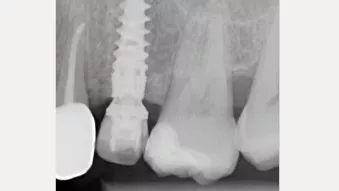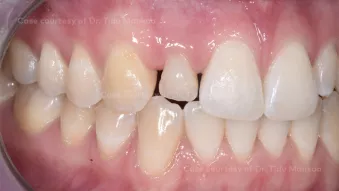
Surface chemistry cells can't resist.
Xeal™ abutment surface and TiUltra™ implant surface. Nobel Biocare’s extensive expertise in anodization technology is applied to the full implant system, from abutment to apex.
New white paper!
Successful clinical outcomes with TiUltra™ surface: Emerging data
At Nobel Biocare, science is at the heart of everything we do. This white paper reveals groundbreaking insights from over 1,270 patients, 2,000 TiUltra implants, and 12 clinical studies.

Xeal™ abutment surface for strong and stable soft tissue attachment to protect underlying bone and promote natural esthetics
Tissue integration begins here. Soft tissue attachment contact with an abutment can act as a barrier that protects the underlying bone. This is the basis for long-term tissue health and stability.4-7
Surface chemistry and topography that are specially designed to promote soft tissue attachment.1,8
Surface chemistry to enhance cell attachment.1,8

On1™ concept
Preserve the soft tissue attachment without compromising flexibility.

Multi-unit Abutment
Carefully designed to rehabilitate both edentulous and partially edentulous arches.
Implant surface technologies
Roughness, porosity, and surface chemistry are important factors for tissue integration. Surface chemistry plays an especially vital role in enhancing cell attachment.9-11
TiUltra™ implant surface - more than roughness
Ideal tissue integration isn’t just about surface roughness, it’s about how every surface reacts with the tissue around it. The TiUltra surface is ultra-hydrophilic, anodized, with a gradual change in topography, becoming moderately rough and porous towards the implant apex.9,12,1

Non porous nanostructured collar
At collar level, the TiUltra surface is non-porous and nanostructured. Its golden hue is a happy byproduct of the specific oxide thickness achieved during anodization.9
Collar designed for bone stability
TiUltra implant surface applied in the collar region features surface chemistry and topography that are designed to promote early osseointegration and are designed to support bone stability.9,14
Pristine surface
The surface chemistry and hydrophilicity of Xeal and TiUltra surfaces are preserved with the protective layer. This ensures that every implant and abutment arrives in pristine condition – to you and to your patients.8,9
Clinical performance of Xeal™ and TiUltra™ surfaces in peer-reviewed publications.
Since their introduction in 2019, Xeal and TiUltra surfaces have been documented in a number of scientific publications. View the list of the key studies and clinical cases, the summaries of their findings, as well as the information on the products included in the investigations.
Clinical cases on TiUltra™ implant surfaces
Discover the real-life performance of TiUltra implant surfaces. Explore our clinical cases and witness how our innovative products are transforming patients' lives.
-
 Immediate implant placement and immediate implant loading with NobelActive® TiUltra™ implant and On1™ Base Xeal™ implant
Immediate implant placement and immediate implant loading with NobelActive® TiUltra™ implant and On1™ Base Xeal™ implantClinician: Dr. Giacomo Fabbri
-
 Restoration of a missing lateral incisor
Restoration of a missing lateral incisorClinician: Dr. Tidu Mankoo
References
See Instructions For Use for full prescribing information, including indications, contraindications, warnings and precautions.
- Susin C, Finger Stadler A, Fiorini T, et al. Safety and efficacy of a novel anodized abutment on soft tissue healing in Yucatan mini-pigs. Clin Implant Dent Relat Res 2019;21(Suppl 1):34-43.
Read online - Roffel S, Wu G, Nedeljkovic I, et al. Evaluation of a novel oral mucosa in vitro implantation model for analysis of molecular interactions with dental abutment surfaces. Clin Implant Dent Relat Res 2019;21(Suppl 1):25-33.
Read online - Hall J, Neilands J, Davies JR, et al. A randomized, controlled, clinical study on a new titanium oxide abutment surface for improved healing and soft tissue health. Clin Implant Dent Relat Res 2019;21(Suppl 1):55-68.
Read online - Rompen E, Domken O, Degidi M, et al. The effect of material characteristics, of surface topography and of implant components and connections on soft tissue integration: a literature review. Clin Oral Implants Res 2006;17(Suppl 2):55-67.
Read on PubMed - Alva H, Prasad KD, Prasad AD. Bioseal: The physiological and biological barrier for osseointegrated supported prosthesis. J Dent Implant 2013;3:148-152.
Read online - Touati B, Rompen E, Van Dooren E. A new concept for optimizing soft tissue integration. Pract Proced Aesthet Dent 2005;17(10):711-715.
Read on PubMed - Schupbach P, Glauser R. The defense architecture of the human periimplant mucosa: a histological study. J Prosthet Dent 2007;97(6 Suppl):S15-25.
Read on PubMed - Nobel Biocare. Data on file.
- Milleret V, Lienemann PS, Gasser A, et al. Rational design and in vitro characterization of novel dental implant and abutment surfaces for balancing clinical and biological needs. Clin Implant Dent Relat Res 2019;21(Suppl 1):15-24.
Read online - Albrektsson T, Wennerberg A. On osseointegration in relation to implant surfaces. Clin Implant Dent Relat Res 2019;21(Suppl 1):4-7.
Read online - Nosswitz M, Teale M, Mathes S, et al. Evaluation of anodized surfaces designed for improved soft tissue integration. Foundation for Oral Rehabilitation (FOR) 2019;1-7.
Read online - Wennerberg A, Albrektsson T, Chrcanovic B. Long-term clinical outcome of implants with different surface modifications. Eur J Oral Implantol 2018;11(Suppl 1):S123-S136.
Read on PubMed - Milleret V, Lienemann PS, Bauer S, Ehrbar M. Quantitative in vitro comparison of the thrombogenicity of commercial dental implants. Clin Implant Dent Relat Res 2019;21(Suppl 1):8-14.
Read online - Susin C, Finger Stadler A, Musskopf ML, et al. Safety and efficacy of a novel, gradually anodized dental implant surface: A study in Yucatan mini pigs. Clin Implant Dent Relat Res 2019;21(Suppl 1):44-54.
Read online




